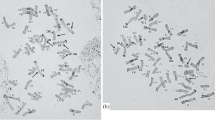Abstract
A series of disomic lines of spring wheat Opal developed on the basis of monosomic lines of this cultivar has been studied. The lines have been tested for combining ability, and the heterosis effect has been studied in disomic lines of F1 hybrids obtained by topcrossing. The line have been demonstrated to differ both from one another and from cultivar Opal in the expression of quantitative traits, combining ability, and the degree of heterosis in F1. These data suggest that recombinations accompanying the formation of the monosomic series have changed their genetic program. To test this suggestion, intramolecular heterogeneity of 42-chromosome plants has been analyzed using polymerase chain reaction (PCR) and isoenzyme analysis. The results confirmed the differences at the DNA and protein levels. According to the results of molecular analyses, A-genome lines are the most polymorphic. Strong heterosis effects have been detected in hybrid combinations contributed by D- and B-genome lines, which are characterized by medium and low degrees of molecular genetic polymorphism. Lines that are promising in terms of breeding programs have been identified.
Similar content being viewed by others
References
Pickett, A.A., Hybrid Wheat—Results and Problems, Suppl. J. Plant Breed., 1993, vol. 15.
Khotyljova, L.V., Dylenok, L.A., Yatsevich, A.P., et al., Aneuploidy as Factors of Genetic Variability Formation In Spring Wheat, Spring Symposium of Plant Cytogenetics, Cieszyn, Poland, 1997, p. 42.
Sears, E.R., Nullisomic Analysis in Common Wheat, Am. Nat., 1953, vol. 87, pp. 245–252.
Stel'makh, A.F. and Buravkova, L.K., Several Peculiarities of Using Monosomic Wheat Lines, Poliploidiya I selektsiya (Polyploidy and Breeding), Nauka i Tekhnika, 1972, pp. 138–149.
Tsil'ke, I.A. and Zharkov, I.A., Identification of Mil'turum 553 Monosomics by Morphological Characters, Nauchno-tekhn. Byull. SibNIIRS, 1981, nos. 6–7, pp. 49–54.
Joshi, B.C. and Singh, D., Heading Date in the Aneuploid Lines of Wheat and Cause of Variation, Wheat Inf. Serv., 1986, nos. 61–62, pp. 58–59.
Dylenok, I.A., Khotyljova, L.V., Khomich, E.A., and Jatsevich, A.P., A New Method for Developing a Series of Monosomic Lines of Spring Wheat Opal, EWAC Newslett., 1995, pp. 24–25.
Kudelko, L.I., Anisimova, N.V., Yatsevich, A.P., and Khomich, E.A., The Combining Ability of Disomic Lines of Spring Wheat Cultivar Opal as Inferred from Plant Height and Its Components, Vests. Akad. Navuk Belarusi, Ser. Biyal. Navuk, 1995, no. 3, pp. 31–35.
Dylyanok, L.A., Yatsevich, A.P., Kudzelka, L.I., et al., Genetic Studies in Wheat with the Use of Aneuploids, Vests. Akad. Navuk Belarusi, Ser. Biyal. Navuk, 1996, no. 1, pp. 69–73.
Gupta, V.P. and Singh, H., Role of Genetic Diversity in Combining Ability of Pennisetum Inbreds, J. Res. Pen. Agr. Univ. Indiana, 1967, vol. 4, no. 1, pp. 41–46.
Sivolap, M.Yu., Topchieva, E.A., and Chebotar', S.V., Identification and Certification of Spring Common Wheat Cultivars by RAPD and SSRP Analyses, Genetika (Moscow), 2000, vol. 36, no. 1, pp. 44–51.
Gerashchenkov, G.A., Gorbunova, V.Yu., Zaryanova, L.D., et al., RAPD–PCR Analysis of the Genome Variation in Spring Soft Wheat Cultivars and Their Androclinal Dihaploid Forms, Genetika (Moscow), 2000, vol. 36, no. 8, pp. 1081–1087.
Korochkin, L.I., Serov, O.L., Pudovkin, A.I., et al., Genetika izofermentov (Genetics of Isozymes), Moscow: Nauka, 1977.
Laemmli, U.K., Cleavage of Structural Proteins during the Assembly of the Head of Bacteriophage T4, Nature, 1970, vol. 227, pp. 680–685.
Caruso, C., Chilosi, G., Caporale, C., et al., Induction of Pathogenesis-Related Proteins in Germinating Wheat Seeds Infected with Fusarium culmorum, Plant Sci. (Limerick, Irel.), 1999, vol. 140, pp. 87–97.
Silva, I.D., Poirier, G.G., and Heath, M.C., Activation of Cysteine Proteases in Cowpea Plants during the Hypersensitive Response—A Form of Programmed Cell Death, Exp. Cell Res., 1998, vol. 245, pp. 389–399.
Shapturenko, M.N. and Khotyleva, L.V., Ways Leading to Genetic Variation in Disomic Lines of Spring Common Wheat Cultivar Opal, Dokl. Nats. Akad. Nauk Belarusi, 2002, vol. 46, no. 6, pp. 71–73.s
Author information
Authors and Affiliations
Rights and permissions
About this article
Cite this article
Shapturenko, M.N., Kudelko, L.I., Yatsevich, A.P. et al. Formation of New Original Material Based on the Genetic Heterogeneity of the Disomic Offspring of Aneuploid Wheat Plants. Russian Journal of Genetics 39, 1265–1270 (2003). https://doi.org/10.1023/B:RUGE.0000004142.24920.d3
Issue Date:
DOI: https://doi.org/10.1023/B:RUGE.0000004142.24920.d3




